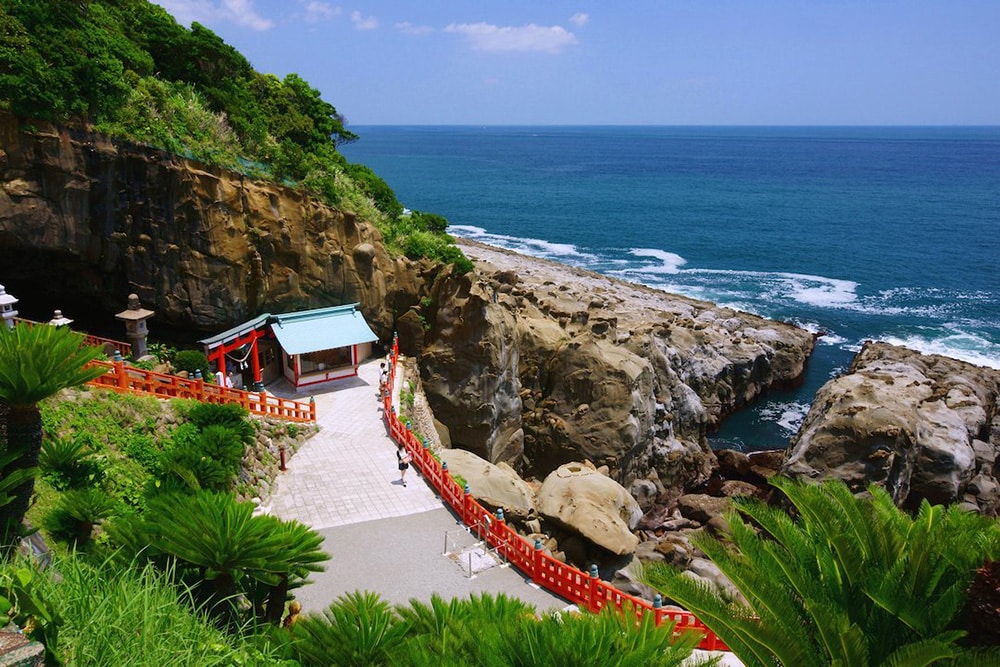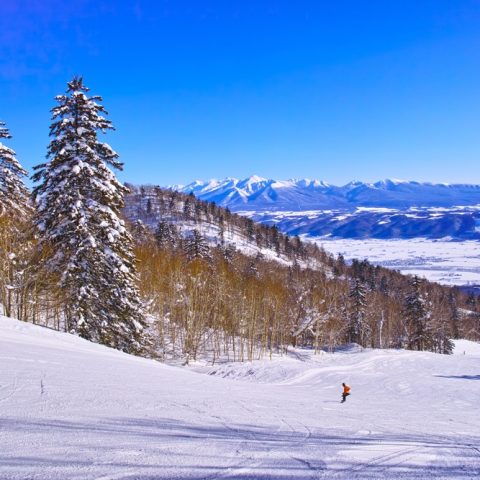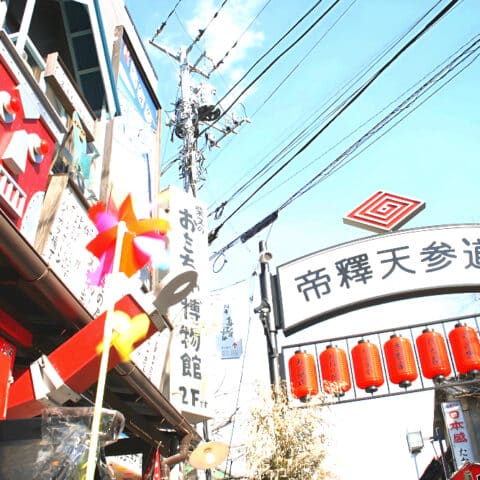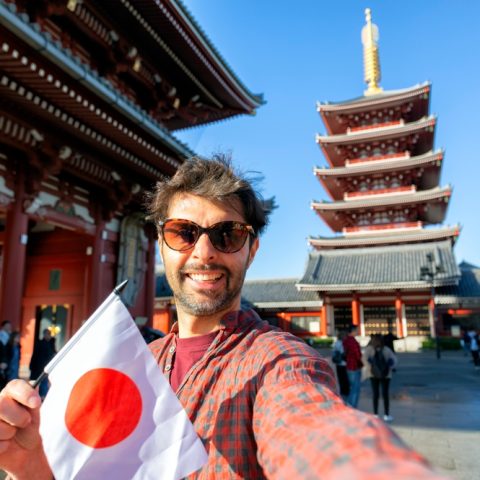
Welcome back to the fourth and final part of Japan’s Ultimate Bucketlist! (You can read here about Part 1, Part 2 and Part 3).
I can’t believe our beautiful–and delicious–adventure through the Japanese prefectures is coming to an end! But dream for just a little bit longer, and join me for this final part of our journey.
We’re in the middle of spring and summertime is slowly approaching. I don’t know about you, but I really need some vitamin sea right now! So let’s discover the southernmost regions of Japan: today we’re talking about Shikoku, Kyushu, and Okinawa.
SHIKOKU

Source: my-kagawa.jp
KAGAWA: STROLL AROUND ONE OF JAPAN’S MOST BEAUTIFUL GARDENS
To see: Ritsurin Garden
The Ritsurin Garden is one of the main attractions of Kagawa prefecture, and it’s easy to see why: this beautiful garden dates back to the early years of the Edo Period (1603-1868), and is considered one of the most beautiful landscaped gardens in the country. Ritsurin Garden was created using the “shakkei” technique, which consists in “borrowing” some external elements and integrating them as if they were part of the garden: among these is Mount Shiun, which perfectly becomes a part of the garden landscape. The compositional principle is summarized in the Japanese saying “ippo ikkei“, which means “one step, one view”, to allude to the number of views and stunning scenarios that open up at every turn. The best way to fully admire this garden is the Kikugetsu-tei tea room: here you can sip various types of Japanese tea and admire the beautiful view.

Source: ana-cooljapan.com
To eat: Sanuki Udon
As we have seen in previous episodes of this guide, there are tons of regional variations of udon. The most famous is certainly the Sanuki Udon typical of Kagawa Prefecture. This udon is characterized by the square shape of its noodles and their flat ends. With more than 600 restaurants, you are spoiled with plenty of options for trying this local specialty. If you have difficulty choosing, you can take advantage of the “udon bus” or “udon taxi” services available in the prefecture which will take you to discover the best Sanuki Udon restaurants!

Source: en.matsuyama-sightseeing.com
EHIME: VISIT THE ONSEN THAT INSPIRED GHIBLI’S “SPIRITED AWAY”
To see: Dogo Onsen
Dogo Onsen is one of the oldest and most famous hot springs in all of Japan, with over 1000 years of history behind it. The main attraction and symbol of the area is the Dogo Onsen Honkan, an old spa dating back to 1894. The wooden facade is decorated with beautiful traditional-style details, but the interiors are even more incredible: a labyrinth of stairs, corridors, and rooms that seem to have inspired the environments and atmospheres depicted by Miyazaki in the famous animated film “Spirited Away”!

Source: visitehimejapan.com
To eat: Mikan
Thanks to its mild temperatures and plenty of sunshine, Ehime is famous for the production of citrus fruits, especially mikan, so much so that it is often referred to as “Mikan Kingdom”. Over 30 varieties of citrus are grown in Matsuyama, and you can find them in stores in the form of fresh fruit, soft drinks, dessert, skin products, and so much more!

Source: miyoshi-tourism.jp
TOKUSHIMA: DISCOVER “GORGE”OUS LANDSCAPES
To see: Oboke and Koboke Gorges
Located at the entrance of the Iya Valley, in a breathtaking natural setting, Oboke and Koboke are spectacular gorges carved into rock by the emerald waters of Yoshino River, the longest watercourse in Tokushima prefecture. You can admire the gorges by taking a boat that offers sightseeing tours, or, for the more adventurous, by taking a rafting, canoeing, or hydrospeed tour! Also, at the departure dock, there’s a rest area called Lapis Oboke, where you can find the Yokai Museum, a small museum dedicated to yokai, ghosts, and magical creatures from Japanese mythology.

Source: discovertokushima.net
To eat: Naruto Kintoki
Small, fluffy-textured sweet potatoes to bite into as snacks! You’ll find these sweet potatoes all over Tokushima and can be enjoyed boiled, steamed, fried, in ice creams, and puddings. No seasoning is needed when eating these sweet potatoes, and their natural sweetness is said to be due to a climate similar to that of the Mediterranean!

Source: visitkochijapan.com
KOCHI: ENJOY THE SEA FROM ANOTHER PERSPECTIVE
To see: Tatsukushi Marine Park
Located at the southernmost coast of Kochi Prefecture, the Tatsukushi Marine Park is home to one of the largest coral reefs in Japan! You will find all kinds of marine life in these waters that stay warm year round. The best way to see the colorful fishes and shellfishes is by hopping on a glass-bottom boat cruise! You’ll also get the chance to admire and explore the stunning mammoth coral reef clusters. Another unique way to admire the sea life is by going to the Ashizuri Underwater Observation Tower, where you can reach seven meters beneath the ocean’s surface–think of it as a reverse aquarium!

Source: visitkochijapan.com
To eat: Katsuo no Tataki
Kochi’s culinary specialty is without any doubt the katsuo no tataki, a seared skipjack tuna commonly served with ginger, spring onion, garlic, and ponzu sauce. The searing method is the secret for the delicious taste of this dish: the tuna–or bonito–filets are placed on a hand-held grill and seared for a few seconds over a strong fire that’s fed with rice straws. This way, the inside will still be raw, but the searing of the outside adds a lovely smokiness!
KYUSHU

Source: ana-cooljapan.com
FUKUOKA: TASTE THE WORLD-RENOWNED RAMEN
To see: Yatai
Yatai are one of the most distinctive symbols of Fukuoka. The yatai are small street food stalls with a maximum of ten seats scattered throughout the city, especially in the area of Nakasu. In the evening, more than a hundred stalls light up their mobile street kitchens, and each of them offers the opportunity to taste local gastronomic specialties in a truly unique atmosphere, including oden, tempura, mentaiko (spicy cod roe), yakitori (grilled chicken skewers), and the famous Hakata ramen, all accompanied by various local alcoholic and non-alcoholic drinks!

Source: visit-fukuoka-japan.com
To eat: Hakata Ramen
The ramen dish par excellence! Hakata is the ancient name of Fukuoka, and this local variety of ramen is the most famous ramen in the Kyushu region and one of the most famous in all of Japan. Hakata ramen is made with a pork bone broth that is particularly thick and creamy thanks to the slow cooking of the ingredients. The dish is then topped with spring onions and chashu (Japanese braised pork belly).

Source: imari-ookawachiyama.com
SAGA: DISCOVER A SECLUDED SIDE OF JAPAN
To see: Okawachiyama
Okawachiyama is a small paradise village for Japanese pottery. This secluded village is often referred to as the “Village of Secret Furnaces” because it was once a famous center that produced porcelain for the Japanese elite, and to protect their pottery technique, the kilns were constructed in a narrow and remote valley. The technique is kept alive to this day, and there are many workshops and shops selling very precious pieces. Strolling through this quaint village is truly a unique experience: you’ll find porcelain pieces set up on streets, walls, bridges, and signs!

Source: ana-cooljapan.com
To eat: Squid
Overlooking the Sea of Japan, Saga prefecture is a seafood paradise, and the squid in particular is renowned all over Japan. This squid can be enjoyed in several ways: as a melt-in-your-mouth sashimi, grilled with salt, or served as tempura. The best way to try it is to head over to the Yobuko morning market, where you’ll find these specialties and many more, like squid dried overnight and squid dumplings!

Source: discover-nagasaki.com
NAGASAKI: HOME OF JAPAN’S MOST FAMOUS SPONGE CAKE
To see: Kojima Shrine
Kojima Shrine is a unique shrine located on an island in Nagasaki prefecture, and is a popular destination for couples, people looking for love, or for those looking to start a family. The access to Kojima Shrine, however, is not that simple: the path that leads to the shrine is only available at certain times of the day due to the changing tide, which either hides or uncovers the path. It’s not easy to get to Kojima Shrine, but it’s absolutely worth it, and you’ll be rewarded with its beauty and magical atmosphere!

Source: discover-nagasaki.com
To eat: Castella
The Kasutera or Castella cake is a dessert popular all over Japan that has its roots in Nagasaki. This honey-flavored sponge cake was originally introduced by Portuguese merchants to Nagasaki in the 16th century, and since then it gained incredible popularity all over Japan, and can be found everywhere from bakeries, to supermarkets and conbinis!

Source: kumamoto.guide
KUMAMOTO: RELAX IN AN ONSEN TOWN SURROUNDED BY NATURE
To see: Kurokawa Onsen
Kurokawa Onsen is a beautiful onsen town located in Kumamoto prefecture, surrounded by a stunning natural setting. In this place, time appears to have stopped, and walking through the main streets you can breathe in a traditional, relaxed atmosphere. In the center of Kurokawa Onsen, you’ll find ancient wooden buildings, small artisan shops and various ryokans. These often offer guided tours to enjoy the local nature, including the Nabegataki Falls.

Source: justonecookbook.com
To eat: Karashi Renkon
Karashi Renkon is Kumamoto’s specialty. It consists of a lotus root, filled with Japanese mustard, miso paste, and honey. The root is then covered with a batter made from wheat flour and turmeric and fried. In the past it was served as a New Year’s dish, but now it can also be found as a component of bento (lunch boxes), served in tea ceremonies, and enjoyed in izakayas as a snack to go with beer or sake!

Source: visit-kyushu.com
OITA: THE STEAMY PREFECTURE
To see: Beppu Onsen – Hells of Beppu
Beppu is considered the onsen capital of Japan. A striking scenario welcomes visitors with white fumes rising from the streets and hot vapors that envelop the buildings. This town has been famous since the Edo Period for hosting around 3000 springs of volcanic origin: some of these were used to create splendid onsen in which to relax, but in others the water can reach a temperature of 99°C! These are called the Hells of Beppu, seven geothermal sites scattered throughout the city, each with its own characteristics. The Umi Jigoku, the most important, for example means “hell of the sea” due to the blue color of the water. There’s also Chinoike Jigoku, the hell of the “lake of blood” that takes its name from the peculiar red color of its thermal waters, or the Oniyama Jigoku, the hell of the crocodiles: a colony of around 100 crocodiles has found its habitat in the warm thermal waters!

Source: visit-kyushu.com
To eat: Steam Cooking
Not only used for onsen, in Beppu steam is also at the heart of the jigoku mushi ryori, a cooking method that dates back to the Edo Period (1603-1868) that involves the use of the thermal waters of the Hells of Beppu. The high temperatures make these waters unsuitable for bathing, but excellent for cooking. Steam cooking allows you to enhance the taste of food and is an extremely healthy method for cooking food. In Beppu you’ll find different self-cooking stations where you can buy the ingredients and cook them in brick structures through which steam passes at very high temperatures.

Source: visitmiyazaki.com
MIYAZAKI: BREATHTAKING COASTAL VIEWS
To see: Udo-Jingu Shrine
Perched on top of a steep cliff overlooking the ocean, the beautiful Udo-Jingu Shrine is a must-see in Miyazaki. While the temple, which can be found in a cave, is particularly striking, the road itself to reach the shrine offers a spectacular view of the coast. Among the rocks, below the panoramic terrace, you will see a target, which consists of a sort of hole carved into the rock, marked by a rope. Here, you can participate in a good luck ritual: after making a wish, visitors have to throw a small clay pebble called undama at the center of the rock–women have to throw the stone with the right hand while men with the left. If you hit it, it is said that your wishes will come true!

Source: visitmiyazaki.com
To eat: Hiyajiru
Summers can get pretty hot in Miyazaki, and Hiyajiru is the refreshing answer to the prefecture’s high temperatures. This cold soup is made with dried sesame and miso that are rubbed together, grilled over a fire, and then mixed with dashi (broth). The soup is then served with tofu, cucumber chunks, shiso, and negi (scallion). Depending on the restaurant, Hiyajiru has different toppings such as sea snails, sardines, or mackerel. This soup is served by pouring it over white rice, but it can also be enjoyed as it is.

Source: kagoshima-kankou.com
KAGOSHIMA: STEP INTO A FAIRYTALE FOREST
To see: Yakushima
Yakushima is an island located in Kagoshima prefecture that is almost completely covered by dense vegetation. The forest of the ancient cedars, in particular, is visited by 300,000 tourists every year. Here live some of the oldest trees in Japan, in some cases even a thousand years old! However, the real jewel in this island is the Shiratani Unsuikyo, one of the most accessible natural parks in Yakushima. When stepping in Shiratani Unsuikyo you’ll immediately feel a magical and fairy tale-like atmosphere: rocks covered with moss, ancient cedars, and a suggestive and lush setting that also inspired Studio Ghibli’s animated film, “Princess Mononoke”!

Source: kagoshima-kankou.com
To eat: Kurobuta (Black Pork)
Kagoshima is the most famous producer of the premium Kurobuta pork, and there are plenty of ways to enjoy this high-quality meat, one of these definitely being the tonkatsu–a Japanese pork cutlet served with shredded cabbage and a soy-based sweet sauce. The two famous types of tonkatsu are called hire (filet, leaner cut) and rosu (loin, a more juicy and marbled cut). Another way to enjoy Kurobuta pork is with shabu shabu: a way of eating many ingredients that are brought to the table raw and then cooked in a boiling broth.
OKINAWA

Source: visitokinawajapan.com
OKINAWA: JAPAN’S TROPICAL PARADISE
To see: Tokashiki Island
Tokashiki Island is the largest of the Kerama Islands, a beautiful archipelago with a tropical atmosphere located around 40 km from Okinawa’s main island. Here you’ll find postcard beaches, lush tropical forests, and a crystal clear sea! It’s truly a dream place for those who want to relax on the beach, snorkel and dive, walk in nature, and at the same time discover a less touristy side of Japan. The climate is mild all year round, and from January to March it is possible to spot whales off the coast during their migration! The coast of Tokashiki is dotted with numerous beaches, but one of the best ways to observe the landscape and the coast of the island is to take a hike and reach one of the many observatories scattered in various points of Tokashiki.

Source: visitokinawajapan.com
To eat: Goya Chanpuru
Okinawa’s traditional cuisine is different from that found on other Japanese islands. The southernmost prefecture of Japan, in fact, has its own particular gastronomic culture: the result of its history, but also of the different climatic conditions and culture. One of the typical dishes of Okinawan cuisine is Goya Chanpuru, a stir fry of the goya vegetable, tofu, pork, and eggs. Goya is a bitter-tasting cucumber that arrived in Okinawa from Southeast Asia and has quickly become one of the most popular vegetables in the prefecture: you’ll find it in tempura, salads, and as pickled, but the goya chanpuru is definitely its most popular and delicious form!
Well, we’ve reached the end of our trip! Thank you so much for joining me in this beautiful and delicious journey. I hope you had as much fun discovering all Japan’s prefectures as I did! I also hope this guide will be useful for your trip planning once the border reopens. Japan has so many things to discover, and I hope this guide will be a starting point for you to explore–and taste–all the amazing things this country has to offer!
Make sure to read about Part 1, Part 2 and Part 3!



